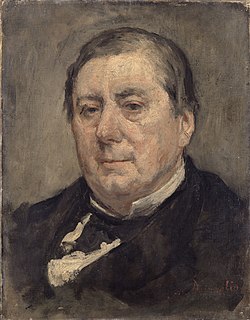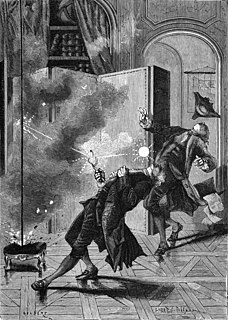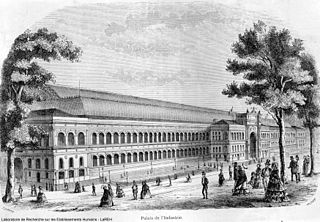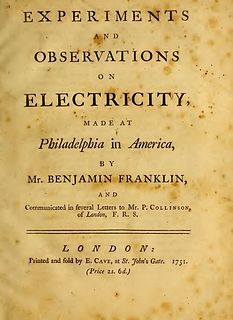
Dom Prokop Diviš, O.Praem. was a Czech canon regular, theologian and natural scientist. In an attempt to prevent thunderstorms from occurring, he inadvertently constructed one of the first grounded lightning rods.

Eugène Marin Labiche was a French dramatist. He remains famous for his contribution to the vaudeville genre and his passionate and domestic pochads.

Sir William Snow Harris was a British physician and electrical researcher, nicknamed Thunder-and-Lightning Harris, and noted for his invention of a successful system of lightning conductors for ships. It took many years of campaigning, research and successful testing before the British Royal Navy changed to Harris's conductors from their previous less effective system. One of the successful test vessels was HMS Beagle which survived lightning strikes unharmed on her famous voyage with Charles Darwin.

An opera hat also called a chapeau claque or gibus is a top hat variant that is collapsible through a spring system, originally intended for less spacious venues, such as the theatre and opera house.

Georg Wilhelm Richmann, was a Russian Imperial physicist of Baltic German descent. Richmann did pioneering work on electricity, atmospheric electricity, and calorimetry. He died by electrocution in St. Petersburg when struck by apparent ball lightning produced by an experiment attempting to ground the electrical discharge from a storm.
Thomas-François Dalibard was a French physicist.

A lightning rod or lightning conductor (UK) is a metal rod mounted on a structure and intended to protect the structure from a lightning strike. If lightning hits the structure, it will preferentially strike the rod and be conducted to ground through a wire, instead of passing through the structure, where it could start a fire or cause electrocution. Lightning rods are also called finials, air terminals, or strike termination devices.

Franklin bells are an early demonstration of electric charge designed to work with a Leyden jar. Franklin bells are only a qualitative indicator of electric charge and were used for simple demonstrations rather than research. This was the first device that converted electrical energy into mechanical energy in the form of continuous mechanical motion, in this case, the moving of a bell clapper back and forth between two oppositely charged bells.

The first International Exposition of Electricity in Paris ran from August 15, 1881 through to November 15, 1881 at the Palais de l'Industrie on the Champs-Élysées. It served to display the advances in electrical technology since the small electrical display at the 1878 Universal Exposition. Exhibitors came from the United Kingdom, United States, Germany, Italy and the Netherlands, as well as from France. As part of the exhibition, the first International Congress of Electricians presented numerous scientific and technical papers, including definitions of the standard practical units volt, ohm and ampere.

Jacques Barbeu-Dubourg was a French physician, botanist, writer, translator and publisher known for translating Benjamin Franklin's work into French and for inventing a gentlemen's umbrella fitted with a lightning conductor. He designed a method of histographic visualizations which he called the Carte chronographique.

The kite experiment is a scientific experiment in which a kite with a pointed, conductive wire attached to its apex is flown near thunder clouds to collect electricity from the air and conduct it down the wet kite string to the ground. It was proposed and may have been conducted by Benjamin Franklin with the assistance of his son William Franklin. The experiment's purpose was to uncover the unknown facts about the nature of lightning and electricity, and with further experiments on the ground, to demonstrate that lightning and electricity were the result of the same phenomenon.

Fashion in the twenty years between 1775–1795 in Western culture became simpler and less elaborate. These changes were a result of emerging modern ideals of selfhood, the declining fashionability of highly elaborate Rococo styles, and the widespread embrace of the rationalistic or "classical" ideals of Enlightenment philosophes.

Experiments and Observations on Electricity is a mid-eighteenth century book consisting of letters from Benjamin Franklin. These letters concerned Franklin's discoveries about the behavior of electricity based on experimentation and scientific studies. The book came in pamphlet form for the first three English editions. The last two editions were in a book volume with hard covers and a book spine. There were eleven European editions of the book: five English editions, three French editions, and a German, Italian and Latin edition. The publication was well received worldwide. It was considered America's most important scientific book of the eighteenth century.

Franklin's electrostatic machine is a high-voltage static electricity-generating device used by Benjamin Franklin in the mid-18th century for research into electrical phenomena. Its key components are a glass globe which turned on an axis via a crank, a cloth pad in contact with the spinning globe, a set of metal needles to conduct away the charge developed on the globe by its friction with the pad, and a Leyden jar – a high-voltage capacitor – to accumulate the charge. Franklin's experiments with the machine eventually led to new theories about electricity and inventing the lightning rod.

A Eugénie hat is a small women's hat that is usually worn tilted forwards over the face, or it may be angled low over one eye. Typically, it is made of velvet or felt, although a variety of materials may be used. The classic design also has a plume of feathers, although other trims may be used.

The Chapeau à la Paméla, Pamela hat or Pamela bonnet described a type of straw hat or bonnet popular during the 1790s and into the first three quarters of the 19th century. It was named after the heroine of Samuel Richardson's 1741 novel Pamela; or, Virtue Rewarded. While Pamela hats and bonnets underwent a variety of changes in shape and form, they were always made from straw. The mid-19th-century version of the Pamela hat was a smaller version of an early 19th-century wide-brimmed style called the gipsy hat.

Jacques de Romas was a French physicist.

The Italian Straw Hat is a five-act comedy by Eugène Labiche and Marc-Michel. It premiered at the Théâtre du Palais-Royal in Paris on 14 August 1851. It has been adapted for the cinema in French, English, German, Czech and Russian, and as a musical play in English and Italian versions. The piece remains regularly staged in France, where it entered the repertoire of the Comédie-Française in Paris and of theatres in other French cities.

Louis-François-Marie Nicolaïe, better known as Clairville, was a 19th-century French comedian, poet, chansonnier, goguettier and playwright.

Jean-Baptiste Le Roy was an 18th-century French physicist and one of the major contributors to the Encyclopédie by Diderot and d’Alembert for technology. The son of 18th-century Parisian clockmaker and watchmaker Julien Le Roy, he had three brothers: Pierre (1717–1785), a brilliant clock-maker in his own right, Julien-David (1724–1803), a neo-classical architect and archaeologist, and Charles a physician and Encyclopédiste.




















